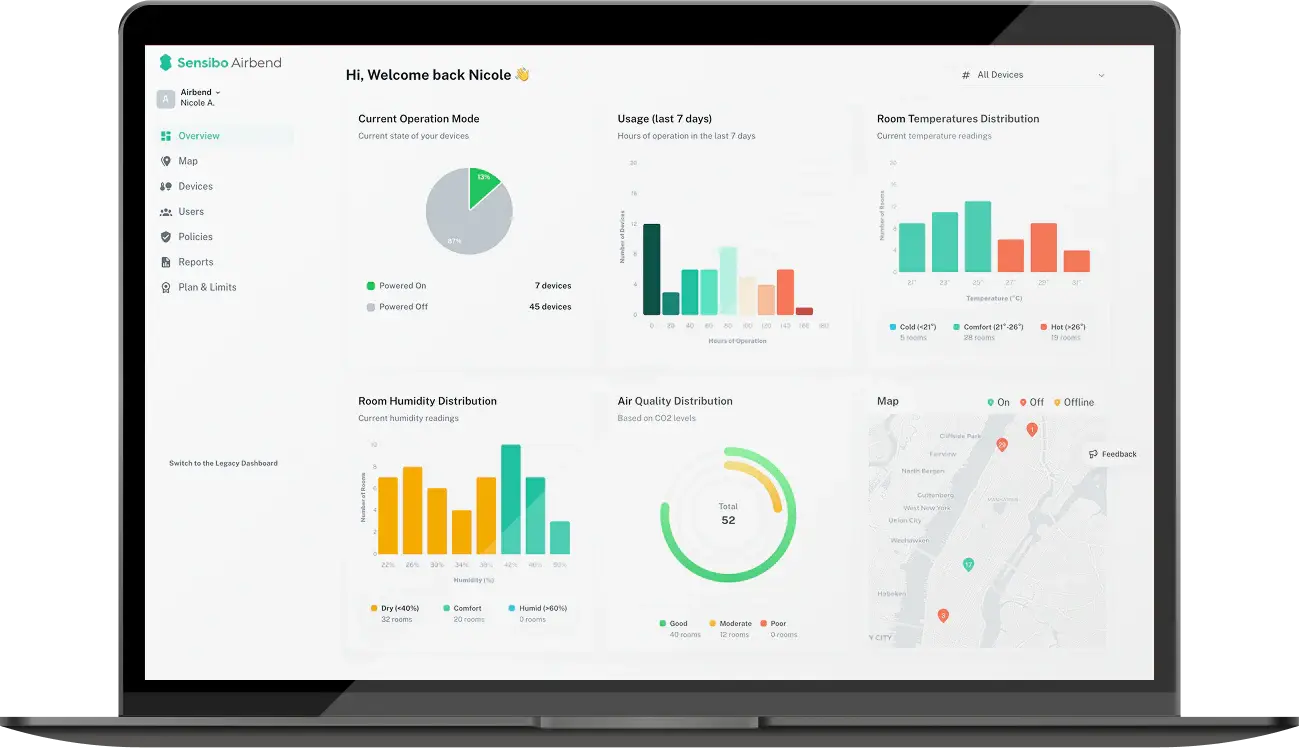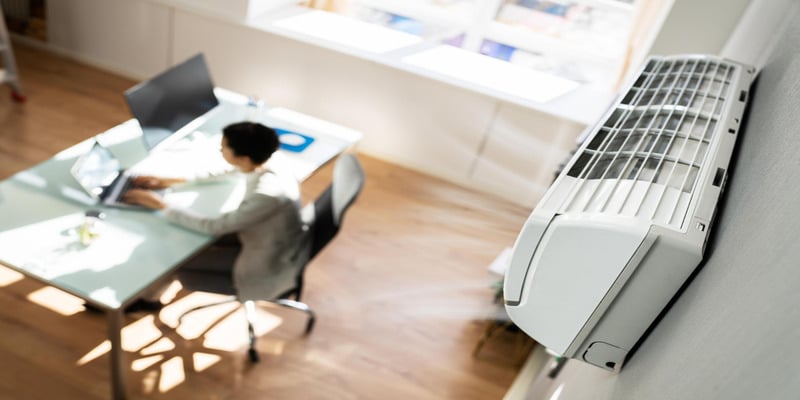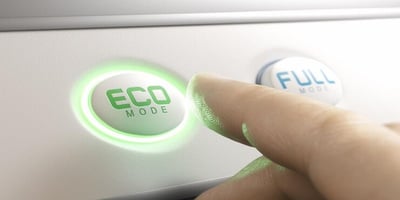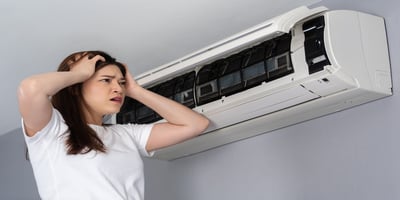When to Use Fan Mode in AC: A Complete Guide for Homeowners
Key Takeaways
- Energy savings: Using fan mode without cooling reduces energy consumption, helping save on electricity bills.
- Comfort and air circulation: Fan mode ensures even temperature distribution throughout the room, enhancing comfort.
- Prolonged lifespan of the AC: Switching to fan mode instead of cooling reduces stress on the compressor, extending its lifespan.
- Eco-friendliness: Continuous use of the fan helps lower humidity levels and improves air quality, making the environment healthier.
At Sensibo, we've analyzed data from over 500,000 connected air conditioners worldwide. One surprising pattern emerged: most users rarely adjust their fan mode on AC systems, sticking with default settings that often waste energy or deliver suboptimal comfort. Our data shows that households effectively using fan modes save an average of 17% on cooling costs while reporting higher satisfaction with their indoor climate.
This untapped potential of your AC's fan settings represents one of the simplest ways to improve your home's comfort and efficiency. Based on our extensive research and customer feedback, we've compiled this comprehensive guide to help you maximize your air conditioner's capabilities through smarter fan usage.
-
What Exactly is Fan Mode and How Does It Work?
-
The Different Fan Settings Explained
-
Strategic Times to Use Fan Mode on AC
-
Energy Implications of Fan Settings
-
Comfort Benefits Beyond Energy Savings
-
Practical Fan Mode Strategies for Different Home Types
-
Common Mistakes When Using Fan Mode
-
FAQ
What Exactly is Fan Mode and How Does It Work?
What does AC fan mode do? Unlike the cooling function that activates your air conditioner's compressor and actually cools the air, the fan component simply moves air around your home. Think of your AC system as having two main components: the cooling mechanism (which includes the compressor and refrigerant) and the air handler (which contains the fan).
When you set your system to fan mode in AC, you're running only the air handler without engaging the cooling components. The fan pulls air from your home through return vents, passes it over the evaporator coil (which won't be cooling in pure fan mode), and pushes it back out through your supply registers.
 Most air conditioners offer two primary fan settings on the AC:
Most air conditioners offer two primary fan settings on the AC:
- AUTO: The fan runs only when the cooling system runs
- ON: The fan runs continuously, regardless of whether cooling occurs
Newer, more advanced systems might include additional options like:
- CIRCULATE: Runs the fan periodically (typically 20-30 minutes per hour)
- SCHEDULED: Allows programming specific times for fan operation
The Different Fan Settings Explained
The AC fan setting you choose significantly impacts both comfort and energy consumption. Let's break down how each option affects your home:
AUTO Mode
When set to AUTO, your fan kicks on simultaneously with the cooling cycle and shuts off when the desired temperature is reached. This setting:
- Runs the fan roughly 20-50% of the time during hot weather
- Allows moisture collected on the evaporator coil to drain properly
- Consumes less electricity than constant operation
- Provides less consistent air circulation
AUTO works well for most households during normal conditions and represents the default setting on most thermostats.
ON Mode
The ON setting keeps your fan running 24/7, regardless of whether cooling occurs. This continuous setting:
- Creates more consistent air circulation throughout your home
- Reduces temperature variations between rooms
- Prevents stagnant air pockets in less-used areas
- Increases electricity consumption for fan operation
- May reintroduce humidity into your home as moisture evaporates from the coil during non-cooling periods
- Requires more frequent filter changes due to constant airflow
CIRCULATE Mode
Available on some newer thermostats, this middle-ground option runs the fan for a preset period each hour. The circulate fan mode on the AC typically:
- Runs 20-30 minutes per hour when cooling isn't active
- Balances energy consumption with air circulation benefits
- Reduces humidity reintroduction issues
- Helps maintain more consistent temperatures than AUTO without the full energy penalty of ON
Strategic Times to Use Fan Mode on AC
Knowing when to use each air conditioner’s fan mode settings helps maximize both comfort and efficiency. Here are specific scenarios where changing your fan setting makes sense:
Morning and Evening Transitions
During spring and fall, when outdoor temperatures swing dramatically between day and night, using ON mode in the morning and evening can help:
- Quickly distribute cooler outdoor air throughout your home
- Delay the need for mechanical cooling
- Flush out stale air that accumulated overnight
This strategy works especially well when combined with opening windows during cooler periods.
During Mild Weather
When temperatures hover between 65-75°F, running fan mode on the AC without cooling often provides sufficient comfort. The air movement creates a cooling sensation on your skin through evaporation, potentially allowing you to set your thermostat 2-4 degrees higher while maintaining comfort.
After Cooking or Showering
Activities that generate heat and humidity can create uncomfortable microclimates within your home. Running the fan after these activities helps:
- Distribute heat and humidity throughout the house rather than concentrating it in one area
- Reduce the workload on your cooling system
- Prevent your AC from short-cycling due to localized hot spots
When Occupancy Patterns Change
If your home sits empty during workdays but fills up evenings and weekends, adjusting fan operation accordingly optimizes comfort and efficiency:
- Weekday daytime: AUTO mode to minimize energy use
- 30 minutes before arriving home: Switch to ON mode
- Once home temperatures stabilize: Return to AUTO or CIRCULATE
This approach pre-mixes the air in your home before arrival, eliminating hot spots without running the fan unnecessarily all day.
Energy Implications of Fan Settings
 Does fan mode in the AC save electricity? The answer depends entirely on how and when you use it.
Does fan mode in the AC save electricity? The answer depends entirely on how and when you use it.
Your AC fan typically consumes 500-700 watts when running—significantly less than the 2,000-3,500 watts used when both the fan and compressor operate. However, running the fan continuously still adds to your electric bill.
Here's the breakdown for a typical 3-ton central AC system:
|
Fan Setting |
Daily Fan Operation |
Monthly Fan Electricity Cost* |
|
AUTO |
~8 hours |
$12-$20 |
|
CIRCULATE |
~12-15 hours |
$18-$30 |
|
ON |
24 hours |
$36-$50 |
*Based on average electricity rates of $0.15/kWh
The ideal setup balances these costs against comfort benefits. For many homes, the CIRCULATE setting (if available) or strategic use of ON during specific times provides the best compromise.
In certain scenarios, using fan mode on the AC actually increases overall energy use by:
- Reintroducing humidity that your system previously removed
- Distributing heat from attics or warm areas throughout otherwise cool spaces
- Adding heat generated by the fan motor itself (especially older PSC motors)
Newer variable-speed fans with ECM motors use 60-80% less electricity than older PSC motors, making the energy penalty for continuous operation much smaller.
Comfort Benefits Beyond Energy Savings
While energy efficiency matters, comfort often drives homeowner decisions about AC fan mode. Strategic fan operation improves comfort by:
Reducing Temperature Stratification
Warm air rises while cool air sinks, creating temperature layers in your home—especially in rooms with high ceilings. Continuous or periodic fan operation mixes these layers, reducing the temperature difference between your floor and ceiling from potentially 8-10 degrees to just 2-3 degrees.
Eliminating Stagnant Air Pockets
Furniture arrangements, closed doors, and room layout can create dead zones where air barely moves. These stagnant areas often feel stuffy and uncomfortable, even when your thermostat shows the correct temperature. Regular fan operation helps break up these pockets and distribute conditioned air more evenly.
Improving Air Filtration
Your HVAC filter only cleans air when the fan runs. Homes with allergy sufferers or air quality concerns benefit from increased filtration that comes with more frequent fan operation. This aspect makes continuous fan mode on AC valuable for those with respiratory sensitivities despite the slightly higher operating cost.
Creating White Noise
The consistent sound of air flowing through ducts creates white noise that many people find soothing for sleep or concentration. This background sound also helps mask outdoor noises or sounds from other parts of the house.
Practical Fan Mode Strategies for Different Home Types
Your optimal fan strategy depends significantly on your home's specific characteristics:
Single-Story vs. Multi-Story Homes
In multi-level homes, temperature stratification becomes a major comfort issue:
- Single-story homes: AUTO mode often works well, with occasional ON during temperature transitions
- Two-story homes: CIRCULATE or ON helps prevent the second floor from becoming significantly warmer than the first
- Split-level homes: More frequent fan operation helps counter the natural temperature differences between levels
For homes with multiple HVAC zones, coordinate fan operation between systems to prevent one from working against another.
Open Floor Plans vs. Divided Layouts
Home layout dramatically affects air distribution:
- Open floor plans: Air circulates naturally; AUTO mode is often sufficient
- Compartmentalized layouts with many walls: Benefit from more frequent fan operation to distribute air between separated spaces
- Homes with closed-off rooms: May require targeted fan mode on AC strategies, including periodic door opening or the installation of jump ducts
Regional Climate Considerations
Your local climate should influence fan operation:
- Humid climates (Southeast, Gulf Coast): Favor AUTO mode to maximize dehumidification
- Dry climates (Southwest): ON mode works well without humidity concerns
- Variable climates (Midwest, Mid-Atlantic): Adjust seasonally between settings
 Common Mistakes When Using Fan Mode
Common Mistakes When Using Fan Mode
Even when homeowners understand the basics of fan operation, these common mistakes can undermine comfort and efficiency:
Ignoring Filter Maintenance
Continuous fan operation means your filter works harder and clogs faster. Neglecting timely replacements when using ON mode leads to:
- Restricted airflow that strains your system
- Reduced effectiveness of air distribution
- Potential system damage from overheating
When using continuous fan settings on AC, check filters monthly and replace them every 1-2 months rather than the standard 3-month interval.
Misunderstanding Humidity Management
Many homeowners don't realize that fan operation after cooling cycles can reintroduce humidity. In humid climates, using the ON mode might:
- Make your home feel warmer and cozier
- Negate some of your AC's dehumidification benefits
- Create conditions favorable for mold and mildew
If humidity control is a priority, stick with AUTO or CIRCULATE modes.
Overlooking Register Balancing
Your supply registers need seasonal adjustments to work effectively with your chosen fan strategy:
- Summer: Upstairs registers more open, downstairs partially closed
- Winter: Reverse the pattern
- ON mode: More crucial to optimize register positions for balanced airflow
Your AC's fan switch offers more control over your home's comfort than most people realize. Play around with different settings during various weather conditions and times of day. You might be surprised how much a small adjustment changes both how your home feels and what you pay for electricity each month
FAQ
Should I run the fan if the AC isn't cooling properly?
No, running the fan when your cooling system isn't working properly won't fix the underlying issue. It may actually mask symptoms that could help diagnose the problem. Your AC likely isn't cooling due to dirty filters, low refrigerant, a frozen coil, or compressor issues. Get a professional diagnosis rather than trying to compensate with fan mode.
Will running the fan continuously wear out my system faster?
Yes, somewhat. The fan motor's lifespan is measured in running hours, so continuous operation accelerates wear on bearings, the blower wheel, and electrical components. Modern ECM motors handle continuous duty much better than older PSC motors, though. If you have a newer system with an ECM motor, this becomes less of a concern.
Does closing vents in unused rooms save energy when using fan mode?
No. Closing more than 20% of your registers increases pressure in your duct system, reducing efficiency and potentially damaging your blower motor. This approach also increases air leakage through duct seams and creates noise from higher air velocity. Consider a proper zoning system instead for seldom-used areas.
How should I set my fan when leaving for vacation?
Use AUTO mode with the temperature at 85°F during cooling season or 55°F during heating season. In mild weather, leave cooling and heating off with the fan still on AUTO. Continuous or periodic fan operation while away serves no purpose in an empty house and wastes electricity. Your return will be more comfortable if you remotely activate normal settings a few hours before arriving home.



































.jpg?height=200&name=photo_2024-02-27_19-55-57%20(1).jpg)
.jpg?height=200&name=photo_2024-01-16_18-35-46%20(1).jpg)

